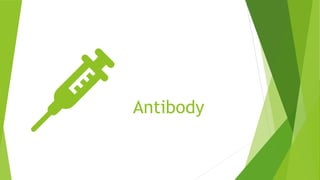
Antibody
- 1. Antibody
- 2. Antibody Antibodies are produced in response to the invasion of foreign molecules in the body. An antibody is defined as ‘’an immunoglobulin capable of specific combination with the antigen that caused its production in a susceptible animals.’ Human immunoglobulins are group of structurally and functionally similar glycoprotein that confer humoral immunity.
- 3. Structure Antibodies exist as one or more copies of a Y- shaped unit, composed of four poly peptide chains. Each Y contains two identical copies of light chain, and two heavy chain , named as such by their relative molecular weights. This Y-shaped unit is composed of the two variable, antigen specific F (FC) arms, which are critical for actual antigen binding and the constant “FC” tail binds immune cell FC receptors.
- 4. Subclasses Antibodies can be divided into five classes : IgG, IgM, IgA, IgD, and IgE based on the number of Y units and the types of heavy chain. Heavy chains of IgG, IgM, IgD, IgG and IgE are known as ɣ, µ, ,α, €, respectively. The light chains of any antibody can be classified as either a kappa (ƙ) or lambda (ƛ) type.
- 5. 1.IgA: In the blood IgA are present in low level in numeric from. They are most active at a mucosal surface where they are present in dimeric from. IgA is produced in mucosal lining that are other types of antibody combined. It major function is to act as a neutralizing antibody.
- 6. High levels of IgA present in saliva, tears, and breast milk. IgA deficiencies are commonly seen in patients with autoimmune disease and allergic disorders. IgA has a half-life of about 5 days.
- 7. 2.IgD: It is monomeric antibody with two epitope binding sites and is found on the surface of most B lymphocytes. Its precise function is still disputed but is suggested to acts as an antigen receptor required for B cell activation. IgD also reported to bind to basophils and mast cells are activated them to produce antimicrobial factors.
- 8. It is also believed to play a role in eliminating B- lymphocytes that produce self- reactive autoantibodies. IgD has a half life of about 3 days.
- 9. 3.IgE: This group of antibodies is effective at mucosal surface, blood and tissues. It is present as monomer consisting of two heavy chains and two light chains . The E chain contains 4 Ig-like constant domains. Most IgE is tightly bound to its receptors on mast cells and basophils via the FC region.
- 10. It plays a crucial role in hypersensitivity reactions and its production is strictly controlled by cytokines. IgE has a half-life of about 2 days.
- 12. 4.IgG: This is the most abundant class of antibodies in the blood, comprising up to 80% of the total serum antibodies. It is present in monomeric from. Four subclasses of IgG have been described depending on their abundance IgG1, IgG2, IgG3, IgG4.
- 13. The subclass produced is dependent on the types of cytokine present IgG has a half – life ranging from 7 to 23 days, depending on its subclass.
- 14. 5.IgM: This class of immunoglobulin is first to be produced in response to infection and is found either on membranes of B cells or as a 5- subunit macromolecule secrete by plasma cells. It is also the first immunoglobulin class to be synthesized by the neotypes. This structure provides multiple binding sites.
- 16. Reference An Introduction to Antibodies and Their Applications 3rd Edition by EMD Millipore.
- 17. Thank You